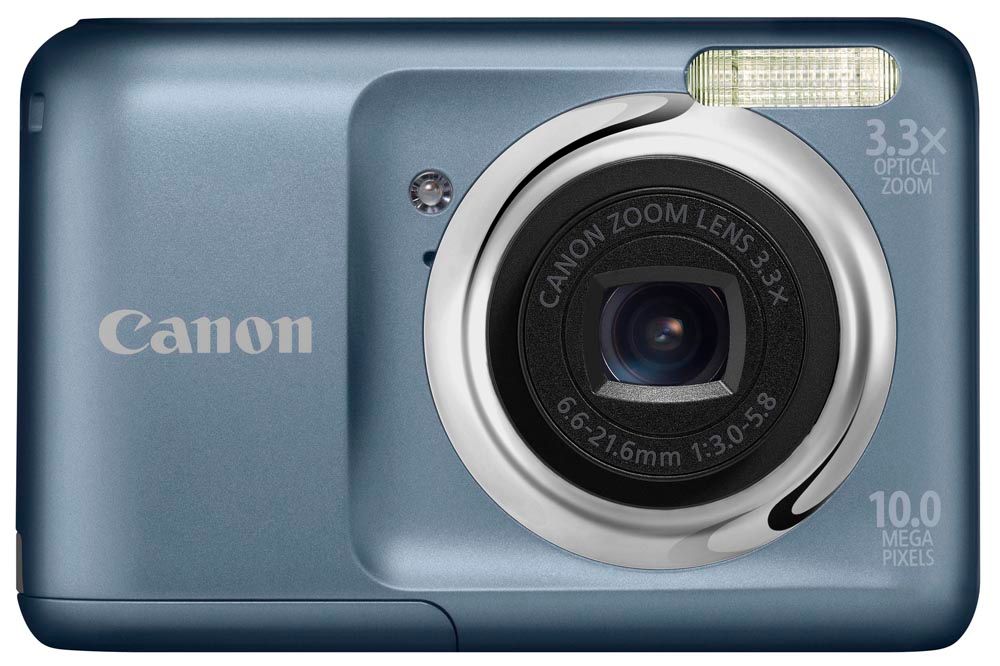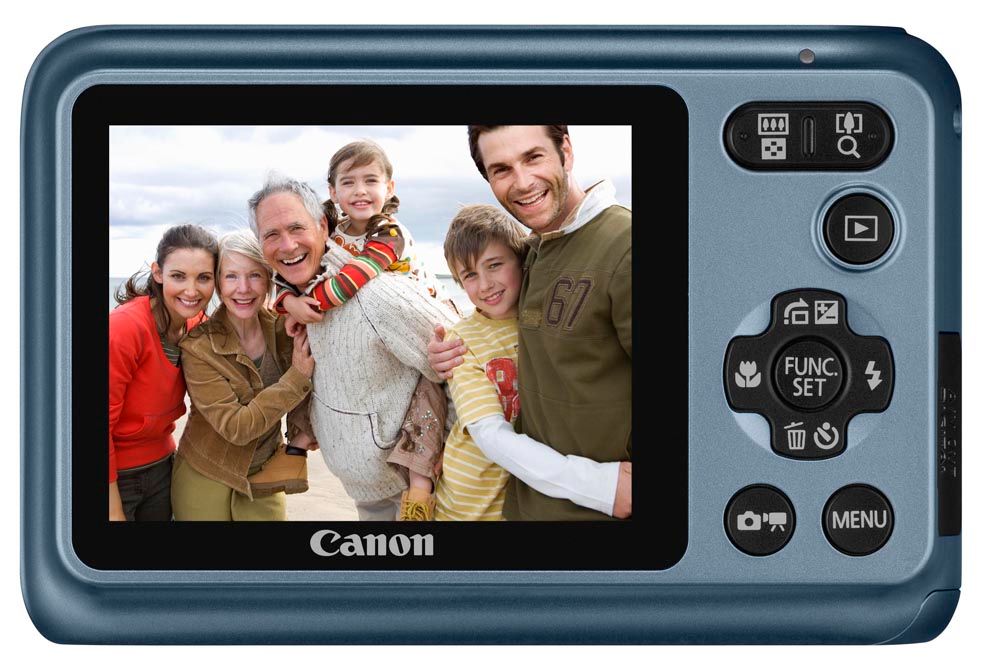At one time all digital cameras were made this way. Fashioned obviously from plastic with a blue-grey hue and power coming courtesy of two bog standard AA batteries, they were viewed as PC peripherals rather than the lifestyle accessories of today.
Our quick take
“Simplicity” and “affordability” are the buzzwords when it comes to the Canon PowerShot A800; its manufacturer can and could do much better, so it’s blindingly obvious this is a product engineered to hit a budget price point and plug a gap in the range. For the money results and feature set are fair, but we’d recommend stretching a little further and opting for a PowerShot A3200 IS that will provide slightly longer service and provide even the most naïve of beginners with a camera they can grow into.

Canon PowerShot A800 - 3.0 / 5
| FOR | AGAINST |
|---|---|
|
|
Upon viewing the new Canon PowerShot A800 it’s like we’ve travelled back 10 years to those more naive, less self-conscious times. Which is a polite way of saying the entry level A800 is, stylistically, a bit of a lump. Red, silver or black are the alternate colours available.
Design
Obviously the two AA batteries that have to squeeze into its chassis are partly to blame for wider than average proportions, but so too is the (almost) pocket money manufacturer’s suggested price tag of just £79, street/online pricing being more enticing still. We found the PowerShot A800 on sale for around £60 at the time of writing.
For your outlay, headline specification includes a 10-megapixel effective resolution from a 1/2.3-inch CCD sensor and a 3.3x optical zoom; sufficient to do the job when pointing and shooting, if hardly, as expected, envelope pushing. Focal range is an equivalent 37-122mm in 35mm terms, so better suited to portraiture than those wider-angle landscape shots. Maximum lens aperture is also distinctly average at F/3.0.
Overall dimensions are 94.3 x 61.6 x 31.2mm and it weighs 186g, so it will still squeeze into pockets. A mirrored chrome ring that encircles the lens provides the only instance of “bling”.
If you require additional stabilisation, a screw thread for attaching a tripod features at the base of the A800, as does a large slide open cover holding the two alkaline AAs in place once inserted (good for a respectable 300 shots), a compartment also shared with the optional removable SD media card of your choice. As is the case with other latest generation Canon’s there’s no longer a modest internal memory to fall back on, so you’ll need that SD/SDHC/SDXC card from the off.
As could be predicted there’s no HDMI output here, just standard AV and USB connectivity under rubber flap at the camera’s side, the opposite flank featuring built-in speaker for replaying the camera’s video recordings.
Control
Backplate buttons and top plate controls are large and obvious, so anyone picking up the camera for the first time will soon be snapping away. The only two controls up top are for turning the camera on and taking a picture, which are inset slightly to avoid accidental activation when reaching for your camera when in bag or pocket. The modest zoom is operated via a thumb pad at the rear, beneath which is a separate playback button for reviewing shots.
Present are familiar cross keys style command pad with exposure, flash, close up and delete/self timer options set at four points around it, plus obvious function/set button at its centre for effecting changes. Beneath this again we find a separate control for switching between stills capture and video capture modes - a dedicated camcorder style record button might have been yet more obvious - along with a self-explanatory menu button for delving further into the A800’s function set.
Also present and correct are standard 4:3 aspect ratio rear plate LCD screen for composing and reviewing images - 2.5-inches in size and with a lowly 115k dot resolution - in the absence of a optical viewfinder. The boxy Canon’s screen is large enough and visibility good enough to function perfectly adequately for day-to-day use.
Performance
The camera powers up from cold in just over 2 seconds, lens extending from its storage position flush to the body and rear screen blinking into life, response times aided and abetted by a Digic III rather than latest generation Digic IV processor. Slightly better than expected is a closest focusing distance of 1cm from your subject.
First time users and casual snappers are the target market here, with Canon’s scene and subject recognising “Smart Auto” technology on board as the default setting from among 16 JPEG-only shooting modes. Maximum ISO setting is the standard ISO 1600, and Canon has even thrown in its Low Light mode here, which effects a resolution drop to 2 megapixels to limit the appearance of image noise/grain.
A half press of the shutter release button and after a brief moment’s adjustment, focus and exposure snap into place, AF point/s appearing on screen as a turquoise rectangle. Press down fully to take the shot and with no discernable shutter delay a maximum 10 megapixel best quality JPEG is committed to card in around 3 seconds, screen briefly blacking out before freezing to display the captured image. Again these timings are average.
As a throwback to simpler times, video here is just a standard definition 640 x 480 pixels at 30 frames per second, to a maximum duration of an hour (requiring a 4GB card). If you want high definition look to the PowerShot A3200 IS or A3300 IS models, for £129 or £149 respectively, which also offer much better builds and styling.
Disappointingly, use of the optical zoom is disabled when recording; a digital variety kicks in instead, undoubtedly because the actual zoom makes a buzzing sound like a mechanical gnat when adjusted. When in stills capture mode, keep your finger on the zoom lever and the camera moves through its 3.3x range in all of 2 seconds, which is fine for framing up your shot.
There is a smidgeon of creativity belying the budget price tag on the A800 courtesy of the ability to select Super Vivid or Poster Art style digital effects to apply in camera from among the side toolbar that appears when selecting scene mode. We also get the familiar Canon “My Colors” options, with the ability to also shoot with a saturation boost or alternatively with a sepia tone.
In terms of image quality, “not bad” seems the most appropriate epithet. Shots are a little softer overall than one might have hoped although close ups work rather better than subjects in the middle distance, and as we mentioned, the lens isn’t really wide enough to squeeze all you might want into shot, so you find yourself shuffling forward and back as you might with a disposable camera to achieve the framing required.
Having said that we were able to achieve even exposures and natural colours, if on the default setting these do lack a little punch. Still, a quick application of Auto Levels in Photoshop adds a bit of contrast and has them looking their best. In terms of low light photography, good results are to be had up to and including ISO 800 - this isn’t a camera whose chip has been overburdened with pixels, after all - though noise/grain is inevitably visible across the entire frame at ISO 1600.
To recap
For those with between £60 and £80 to spend on a snapshot camera for the kids or the mother-in-law, the A800 offers fair value for money, an easy to use feature set and fair results. For what’s being asked here it’s hard to grumble about what’s been left out


